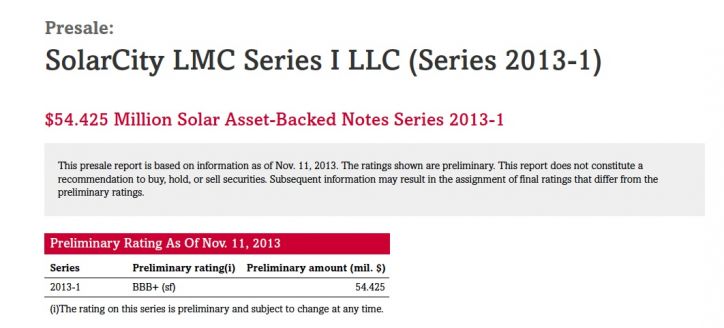The yield number is in.
Earlier this month, SolarCity executed on a solar financing milestone. SolarCity announced its intent to offer a private placement of $54.4 million of an "aggregate principal amount of Solar Asset Backed Notes, Series 2013-1 with a scheduled maturity date of December 2026," as per an SEC document.
That means we've entered the world of securitized solar, and it's the first time it's being employed for distributed PV. (We published "The Encyclopedia of Solar Securitization" in September.)
"Securitization is the practice of pooling disparate sources of debt and selling it as a package to investors on the secondary market," according to GTM's Stephen Lacey. Securitization improves liquidity and can spur demand. (Securitization could be applied to energy efficiency as well.)
But the punchline missing from the SolarCity story was the yield for this offering.
That's just been announced. According to a statement:
"The notes will have an interest rate of 4.80% and a scheduled maturity date of December 21, 2026." The release adds, "The notes will be secured by, and payable solely from the cash flow generated by a pool of photovoltaic systems and related leases and power purchase agreements and ancillary rights and agreements that will be owned by SolarCity LMC Series I, LLC. These notes will represent obligations solely of SolarCity LMC Series I, LLC, and will not be insured or guaranteed by SolarCity Corporation or any other affiliate thereof."
So, is 4.8 percent yield a good number?
A banker colleague notes, "It's not a bad rate. A little under where a swapped bank deal would end up. The release doesn't mention any issuance discount, so I assume this is the yield. Tenor is nothing extraordinary. Rumor is that the required coverage ratio is relatively high, so the amount of leverage is relatively low -- to be expected for a first deal."
Financing lore has it that the debt is usually packaged in $100 million increments, so the $54.4 million number might be due to SolarCity cherry-picking the contents of that particular asset pool. SolarCity could not comment at this time. We understand that the current package is a mix of residential and commercial projects.
Shayle Kann, GTM's VP of research, sees this as potentially "a bigger deal than a solar REIT or MLP." He said it was "no surprise that SolarCity is the first; expect to see Sunrun and others take a shot."
A positive credit rating and strong reception could "open the floodgates" of solar finance, according to Kann. The note is BBB+-rated and SolarCity stock is up 5 percent to $56.66 per share.

It's fair to say that distributed solar has just reached the scale where it can access larger pools of once-unavailable, lower-cost capital. It's another piece of the equation where solar is cutting cost and going mainstream.
John Joshi, a member of the Solar Access to Public Capital working group, said, "We are supportive of the deals in the marketplace, and feel that it is a great milestone for the sector and illustrates the potential for the sector going forward. We applaud the team at SolarCity and CSFB for a great effort in bringing this deal to market. As investors and stakeholders become more knowledgeable of the sector, we expect the sector to grow at a fast rate. The pricing of this deal reflects investor interest in the sector and is very positive for increasing distributed solar penetration." Joshi is also Director of CapitalFusion Partners.
Another seasoned solar financier noted, "There will be buyers at this price."
***
Securitization is one of the hot solar topics to be explored on the upcoming "Standardization and Securitization" panel at GTM Research's U.S. Solar Market Insight conference in December. Panelists include Yuri Horwitz, CEO of Sol Systems, Richard Mull of KPMG, and Nicholas W. Lazares, Chairman of the Board and CEO of Admirals Bank. Learn more about the conference here and register here.



